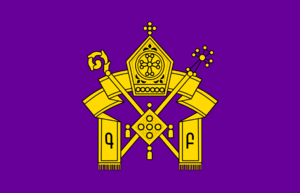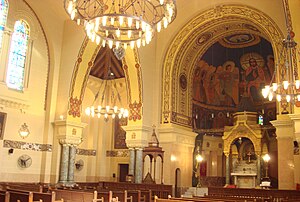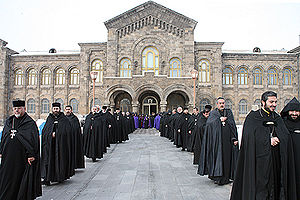
- Image via Wikipedia
Official Website >
Name of the Church
The Church of the People of Armenia is also called the Armenian Apostolic Orthodox Church or simply the Armenian Church.
Historical Origins
The Armenian Church acknowledges as its original founders two of Jesus’ twelve apostles, Thaddeus and Bartholomew, who are referred to as the “first enlighteners of Armenia.” After the apostles’ preaching, there are strong indications that Christianity had taken root in the country long before the year 301ad. On or about that year, a nobleman named Gregory, after much persecution and suffering, and through miraculous means, succeeded in converting the pagan King Trdat of Armenia to the Christian faith. The king, in turn, declared Christianity to be the official religion of Armenia, decades before the Roman Empire became officially Christian. St. Gregory was consecrated a bishop in Caesaria, one of the great Christian centers of the East, and undertook a massive campaign to preach the Christian faith and to baptize the people. Gregory became known as “the Illuminator,” according to the biblical image of baptism as receiving the light of Christ. St. Gregory was also instrumental in converting the neighboring countries of Georgia to the north and Caucasian Albania to the east. Inspired by a vision of our Lord, he also built the first Christian cathedral in Vagharshapat, in the shadows of the biblical Mount Ararat. At first named in honor of Mary the Mother of God, the cathedral came to be known as “Etchmiadzin,” which means, the place where “the Only-Begotten descended.” Holy Etchmiadzin remains the Holy See of the Armenian Church to this day.
Turning Points in History
In 325, the Armenian Church participated in the First Ecumenical Council at Nicea, with St. Aristakes, the younger son of St. Gregory the Enlightener representing his aged father.
Nearly a century later, Catholicos Sahak commissioned the monk Mesrob Mashdots to create an alphabet for the Armenian language with the express purpose of translating the Bible into Armenian, thereby consolidating the Christian faith throughout the land. In one of the great intellectual achievements of human history, within the span of a generation, Mesrob and his disciples had succeeded not only in creating the Armenian alphabet and translating the Bible, but also in translating a library of the great Christian writings of the day into Armenian. Today, many of these writings have perished in their original languages, but survive in accurate Armenian translations.
Becoming the first nation officially to declare Jesus Christ as the one true God was a daring move that would mark the history of Armenia’s contacts with its non-Christian neighbors until the present day. In the fifth century, Armenia’s giant neighbor Persia attempted to separate the Armenians from their Christian faith in order to create a buffer between Persia and the other great superpower of the day, the Roman (Byzantine) Empire, which was also Christian. At the Battle of Avarayr in 451ad, St. Vartan Mamikonian led a small but undaunted army of Armenian soldiers and clergy against a vastly larger Persian army. The priest St. Ghevont, speaking to the Armenian troops on the night before the battle, urged them not to be afraid of their almost certain military defeat because the eternal life in Jesus Christ could never be taken away from them, not even by bodily death. Vartan, Ghevont and more than a thousand Armenians were martyred in the military rout. But their Christian witness galvanized the Armenians, and by the end of the fifth century the Persians had no choice but to grant the Armenians the freedom to follow their God.
Beginning in the fifth century, theological questions concerning the person of Jesus Christ began to wrench the entire Christian East, causing enmity, bloodshed and divisions that plague the church to this day. The eventual Armenian rejection of the Council of Chalcedon (451 ad), particularly the doctrine of two natures in Christ, was based on the Armenians’ discerning in it tacit Nestorianism. During the course of the sixth century the Armenians grew increasingly suspicious of the Chalcedonian doctrine, especially at regional synods in 506 and 554ad. Chalcedon was definitively condemned in 608ad.
In the seventh century, during the Arab occupation of the Holy City, an Armenian Patriarchate was recognized. The first Armenian Patriarch of Jerusalem, Bishop Abraham, held office from 638-669. Until today, the Armenian Patriarchate, headquartered in the vast Armenian Quarter of the Old City, is one of the three Christian communities sharing custody of the Holy Places.
Despite practically unremitting invasions, persecution and domination by the Persians, Arabs, Greeks, Seljuk Turks, Mongols, Mameluks, Ottomans and others, the Armenians found ways to adjust to political, religious, social and economic hardships. Through political prowess, tenacity as well as unyielding faith in their Lord, they were even able to enjoy periods of prosperity and astounding intellectual and artistic creativity. The Bagratid Kingdom was centered in the City of Ani, which, by the standards of the end of the first millennium, was surely one of the great cities of the world. The Cilician Kingdom was carved out of territories abandoned by the Greeks along the southeastern seacoast of Asia Minor. The Cilician period, in the early centuries of the second millennium, was marked by close contact with Greek and, for the first time, Latin Christians, as the Crusaders passed through on their way to defend the Holy Land. Surprisingly unintimidated by these powerful Christian neighbors, Armenian intellects such as Catholicos St. Nersess Shnorhali (“the Grace-filled”) and Nersess of Lambron exhibited a remarkable openness to new ideas, while they ardently protected the authentic identity and witness of the Armenian Church.
The Fall of the Cilician Kingdom in 1375 led to a period of consolidation and stagnation in Armenian church and cultural life. In this environment, the achievements of such luminous leaders and theologians as Hovhannes of Orotn (1388), Gregory of Datev (1410), Mikael of Sebastia (1570), Simeon of Yerevan (1780), and many others are truly remarkable.
The Armenian Patriarchate of Constantinople was created by the Ottoman Turkish rulers in 1461, soon after the conquest of Constantinople, to administer to the religious and civil needs of the large Armenian population of the Empire.
The most characteristic feature of the nineteenth century is the intervention of the laity in the affairs of the church and the creation of “constitutions” for its administration. Armenians in the homeland as well as the Ottoman Empire built schools and seminaries, whose graduates attended European universities and brought back modern ideas and perspectives in politics and the arts.
The great Genocide of the early twentieth century put a devastating end to this promising period. Along with 1.5 million Armenians who were exterminated by decree of Ottoman officials, the church’s clergy, hierarchy, monasteries and institutions were decimated. Of the 5000 clergyman living in 1915, only 400 had survived by 1923. Survivors fled to every corner of the world to rebuild their lives, in the process creating a worldwide diaspora. Be it in the United States, South America, Europe, the Middle East or Australia, Armenian refugees wasted no time in assembling as church communities, building sanctuaries and schools.
Following the decimation and deportation of the Armenian population of Cilicia during 1915-1920, the patriarchal See of Sis was confiscated by the Turkish authorities. In 1929, with the help of the Armenian Patriarch of Jerusalem, Catholicos Sahak II of Cilicia eventually established his seat at Antelias, north of Beirut, Lebanon, under the French mandate.
The growth of the church far from the homeland, especially during the last century in the United States, would serve, in more recent years, as an instrument in reviving the church in Armenia, which endured seventy years of Soviet-imposed suppression. Now freed again from the shackles of hostile totalitarianism, the church in the free and independent Republic of Armenia, currently under the leadership of His Holiness Catholicos Karekin II, is striving to rebuild the church’s institutions and to restore the Christian faith to its traditionally privileged place in the daily life, work and aspirations of the Armenian people. Meanwhile, the Armenian Church in the diaspora faces the challenge of transmitting its unique vision of the Gospel of Jesus Christ to an increasingly affluent, secularized generation that is far removed chronologically, geographically, culturally and ideologically from the cradle where that marvelous tradition of Christian life was born and cultivated.
In 1999, His Holiness Karekin I was elected and consecrated Supreme Patriarch and Catholicos of All Armenians at Holy Etchmiadzin.



